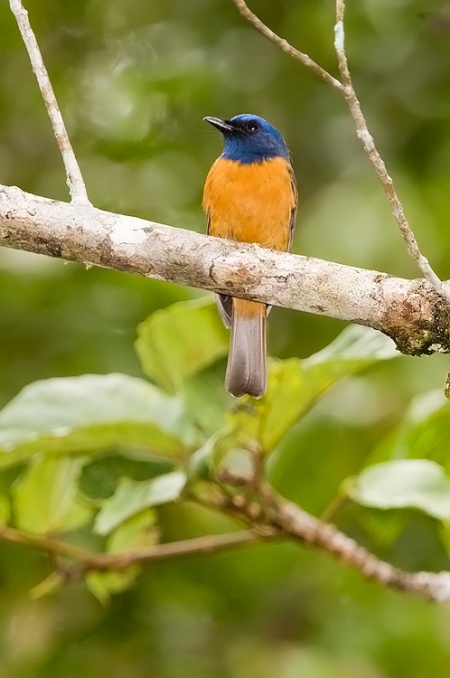m (Blue-fronted Flycatcher moved to Blue-fronted Blue Flycatcher) |
(completed) |
||
| Line 1: | Line 1: | ||
| − | + | [[Image:Blue-fronted_Flycatcher.jpg|thumb|450px|right|Male<br />Photo by {{user|Ignacio|Ignacio}}<br />[[Lore Lindu National Park]], [[Sulawesi]]]] | |
| − | + | '''Alternative names: Blue-fronted Flycatcher; Hoevell's Flycatcher; Celebes Blue Flycatcher''' | |
| − | [[Image:Blue-fronted_Flycatcher.jpg|thumb| | ||
;[[:Category:Cyornis|Cyornis]] hoevelli | ;[[:Category:Cyornis|Cyornis]] hoevelli | ||
==Identification== | ==Identification== | ||
| + | 15cm. A medium-sized Flycatcher with a large bill. | ||
| + | ====Male==== | ||
| + | * Deep blue head, nape, chin and upper breast | ||
| + | * Brighter shining blue on forehead extending along side of crown to behind eye | ||
| + | * Olive-brown upperparts, including upperwings | ||
| + | * Blackish tail with rust-brown outer edges | ||
| + | * Deep orange lower breast, belly and undertail-coverts | ||
| + | * Black bill and legs | ||
| + | ====Female==== | ||
| + | * Grey or grey-brown hood, greyish-buff chin and throat | ||
| + | * Rest of plumage similar to male | ||
| + | Juveniles are brownish with buff spots above and blackish bars and scaling below. | ||
==Distribution== | ==Distribution== | ||
| − | [[Indonesia]]: found in the montane forests of central and south-eastern [[Sulawesi]]. | + | [[Indonesia]]: found in the montane forests of central and south-eastern [[Sulawesi]].<br /> |
| + | Common in its small range. | ||
==Taxonomy== | ==Taxonomy== | ||
| − | This is a [[Dictionary_M-S#M|monotypic]] species<sup>[[#References|[1]]]</sup>. | + | This is a [[Dictionary_M-S#M|monotypic]] species<sup>[[#References|[1]]]</sup>.<br /> |
| + | Forms a superspecies with [[Timor Blue Flycatcher]] and [[Matinan Blue Flycatcher]]. | ||
==Habitat== | ==Habitat== | ||
| − | Moist montanes. | + | Moist montanes. Occurs between 1400 and 2300m. |
==Behaviour== | ==Behaviour== | ||
| + | Few information about diet but includes small vertebrates.<br /> | ||
| + | Forages from undergrowth to lower middle levels of forest.<br /> | ||
| + | Usually seen alone, in pairs or in mixed-species flocks. Easy to overlook and best found when it's singing.<br /> | ||
| + | A resident species. | ||
==References== | ==References== | ||
| − | #{{Ref- | + | #{{Ref-Clements6thOct12}}#{{Ref-HBWVol11}} |
{{ref}} | {{ref}} | ||
==External Links== | ==External Links== | ||
{{GSearch|Cyornis+hoevelli}} | {{GSearch|Cyornis+hoevelli}} | ||
[[Category:Birds]][[Category:Cyornis]] | [[Category:Birds]][[Category:Cyornis]] | ||
Revision as of 19:40, 18 March 2013
Alternative names: Blue-fronted Flycatcher; Hoevell's Flycatcher; Celebes Blue Flycatcher
- Cyornis hoevelli
Identification
15cm. A medium-sized Flycatcher with a large bill.
Male
- Deep blue head, nape, chin and upper breast
- Brighter shining blue on forehead extending along side of crown to behind eye
- Olive-brown upperparts, including upperwings
- Blackish tail with rust-brown outer edges
- Deep orange lower breast, belly and undertail-coverts
- Black bill and legs
Female
- Grey or grey-brown hood, greyish-buff chin and throat
- Rest of plumage similar to male
Juveniles are brownish with buff spots above and blackish bars and scaling below.
Distribution
Indonesia: found in the montane forests of central and south-eastern Sulawesi.
Common in its small range.
Taxonomy
This is a monotypic species[1].
Forms a superspecies with Timor Blue Flycatcher and Matinan Blue Flycatcher.
Habitat
Moist montanes. Occurs between 1400 and 2300m.
Behaviour
Few information about diet but includes small vertebrates.
Forages from undergrowth to lower middle levels of forest.
Usually seen alone, in pairs or in mixed-species flocks. Easy to overlook and best found when it's singing.
A resident species.
References
- Clements, J. F., T. S. Schulenberg, M. J. Iliff, B.L. Sullivan, C. L. Wood, and D. Roberson. 2012. The eBird/Clements Checklist of Birds of the World. 6th ed., with updates to October 2012. Ithaca: Cornell Univ. Press. ISBN 978-0801445019. Spreadsheet available at http://www.birds.cornell.edu/clementschecklist/downloadable-clements-checklist
- Del Hoyo, J, A Elliot, and D Christie, eds. 2006. Handbook of the Birds of the World. Volume 11: Old World Flycatchers to Old World Warblers. Barcelona: Lynx Edicions. ISBN 978-8496553064
Recommended Citation
- BirdForum Opus contributors. (2024) Blue-fronted Blue Flycatcher. In: BirdForum, the forum for wild birds and birding. Retrieved 8 June 2024 from https://www.birdforum.net/opus/Blue-fronted_Blue_Flycatcher




